Will the higher Indian cotton lift up the global cotton price?
International cotton prices weaken impacted by the macro environment under the escalating tensions across Taiwan Strait and the worries over the economic recession, but cotton prices in India and Pakistan show different trends, especially Indian spot cotton price, up from Rs. 85,000 per Candy on Jul 20 to Rs. 91,500 per Candy in early Aug, an increase of Rs. 6,500 or 7.65%. During the same period, Pakistani spot cotton price rises from Rs. 16,500 per maund to Rs. 19,200 per maund, up Rs. 3,700 or 22.4%. The higher cotton prices in Pakistan are mainly because US dollar strengthens largely against Pakistan rupee, up from 204 in July to 238 recently. Spinners increase the cotton procurement on concern about further rupee depreciation, resulting into higher cotton prices. For Indian cotton, it has been the most expensive cotton in the world, but it goes up still. What is the reason and will it exert positive impact on global cotton supply?
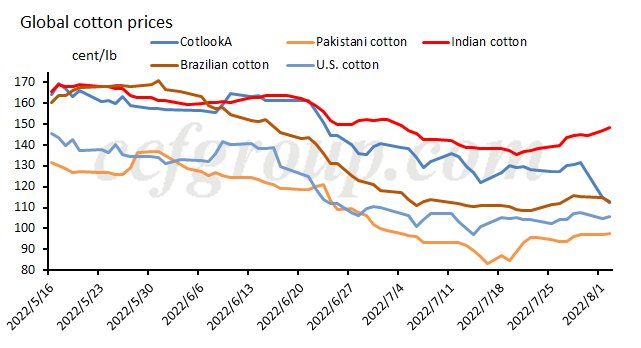
1. Concerns on the new cotton production increase
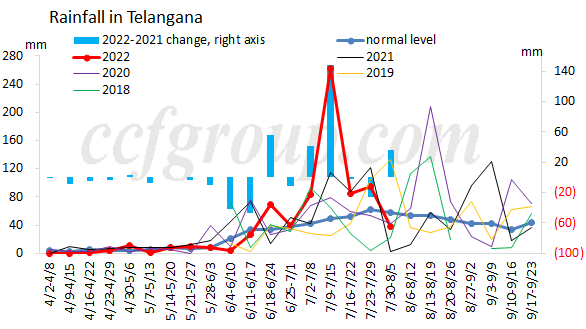
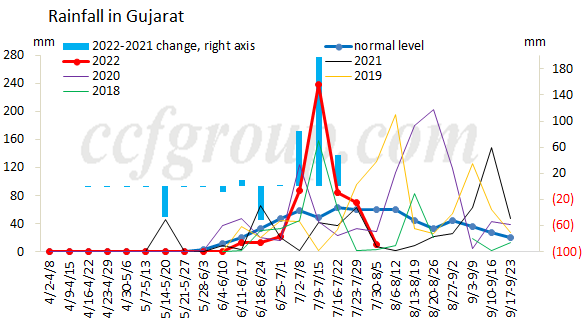
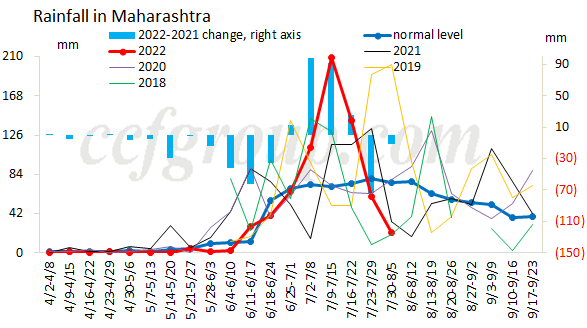
According to the rainfall data, the three major cotton producing areas in India suffered heavy rainfall in the second week of July and caused waterlogging disasters. Although the rainfall declined significantly in the next two weeks, it was still higher than the normal level. According to a recent report by the Department of Agriculture, about 1.07 million hectares of crops were affected in this round of heavy rainfall in Maharashtra, mainly cotton and soybean crops. At the same time, the Department of Agriculture has not announced the planting status of rice, cotton and sugarcane for two consecutive weeks, and is busy arranging subsidies for affected farmers. Market concerns about the production of new cotton increase.
2. Local demand is spurred with coming festivals
Festivals like NagPanchami and Raksha Bandhan will start in Aug, and till Jan, there are other large festivals, like Ganesh Chaturthi, Dusherra, Diwali, Christmas, New Year and Makar Sankranti. Meanwhile, the clients in shopping malls have recovered significantly after India lifts the COVID curbs. The festive season is expected to be different from the past two years this year with no COVID-19 restrictions. According to Retailers Association of India, retail businesses across India reported an average growth of 24 per cent in May this year compared to May 2019. Local demand may be stimulated somewhat.
3. The trade deficit is obvious, hard to change the global cotton supply and demand pattern
Since U.S. raises the interest rates, the Indian rupee has continued to depreciate, and the price of energy under the conflict between Russia and Ukraine has skyrocketed, resulting in a rapid decrease in India's foreign exchange reserves. According to data released by the Reserve Bank of India on July 29, as of July 22, the foreign exchange reserves of the Reserve Bank of India decreased to $571.56 billion. The RBI releases its foreign exchange reserves every Friday. The data showed that the Reserve Bank of India's foreign exchange reserves fell by $1.152 billion compared to the previous week. Combined with the USDA’s weekly export report, the export sales of 2021/22 U.S. upland cotton to India are 113kt, and that of 2022/23 cotton is only 9kt, showing a weak consumption on international cotton. At present, the available foreign exchange reserves have gradually reduced, and India is in a deep trade deficit pattern. At the same time, in order to stabilize the exchange rate, the Indian government has further introduced the rupee international settlement rate, which has further hit the import industry, which also makes India's own inflation difficult to export. Considering that there is still a period of time before the new cotton arrives on the market, new crop production is still uncertain, and consumption is hard to assess. Although India's domestic cotton textile consumption demand has improved recently, the impact of the Indian market on the global cotton market supply and demand may be very limited.
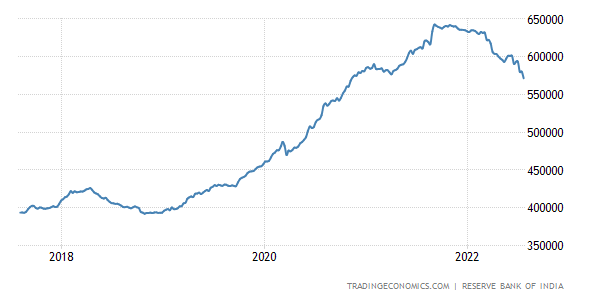
Conclusion
Recently, the main cotton producing areas in India have suffered floods caused by heavy rainfall, and some producing areas are facing the dilemma of replanting. The Department of Agriculture has not announced the cotton planting status for two consecutive weeks, which has caused the market to worry about the production of new cotton. At the same time, the demand for cotton textiles and apparels in India has improved recently, driving up the Indian cotton prices further. However, in the context of the rapid decline of India's foreign exchange reserves, the Indian market has shown poor cotton consumption on international market. Later, U.S. Fed may continue to raise the interest rates, and there is possibility of deflation and consumption is not likely to be spurred. Keep an eye on the Indian new cotton planting condition.
- Top keywords
- Cotton Price
- Cotton Futures Price
- Cotton Futures
- CZCE
- PTA Futures Price
- Chemical Fiber
- Polyester Prices
- Wool price
- PTA Futures
- Shengze Silk
- China
- Yarn Price
- price
- China Textile City
- Fibre Price
- Benzene Price
- Cotton
- Index
- Cotton Index
- PTA
- fabric price
- NYMEX
- Top 10
- textile industry
- Spot Cotton
- Cotton Yarn
- Polyester Price
- Futures
- PTA Price
- cotton yarn price

